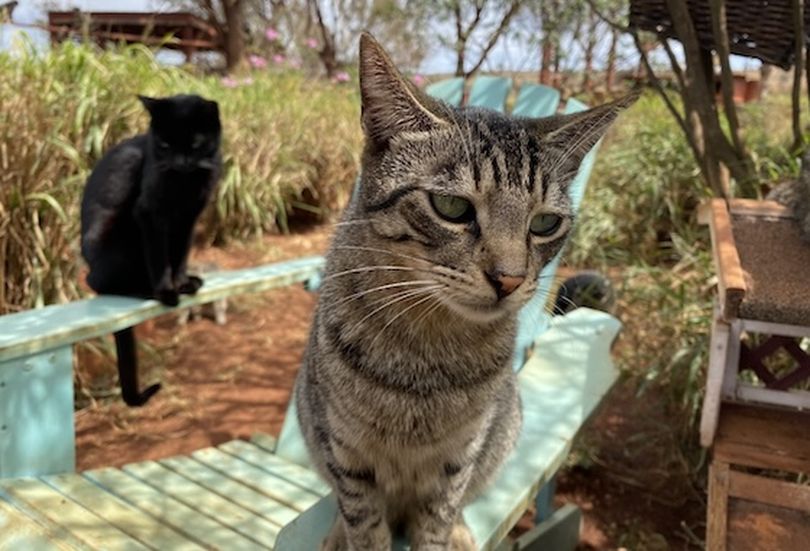The island of Lanai is, uh, the cat’s meow

When anyone mentions Hawaii, any number of images pop into my head. Beaches, hula dancers, shave ice, surfing, volcanoes, Flora Yoro (the girl I was in love with in 9th grade) … and so on.
Before I visited the island of Lanai, I would not have included cats among that list. But once I toured the Lanai Cat Sanctuary, that changed.
Lanai isn’t the first, second, third or even fourth Hawaiian island that people tend to visit. Most people I know vacation on Maui. Kauai is popular, too, as is Hawaii (also known as the Big Island). And most people spend at least some time on Oahu, the most populated island and home of the state capital.
I first visited Hawaii in 1957. My naval officer father was stationed there, and we lived in the village of Wahiawa, on Oahu. We left after a year but returned to Oahu in 1959, just in time to celebrate Hawaii’s becoming a state. We ended up living there for three more years, this time in Ewa Beach.
Over the decades since, I’ve managed to visit six of the eight islands (not Niihau nor Kaho’olawe). My wife Mary Pat and I spent our honeymoon on Maui, part of which entailed a stay in the now-destroyed city of Lahaina and part of which required me to drive the infamous twisting Road to Hana. Twice.
We took a helicopter ride to the highest peak of Kauai before flying along the island’s scenic Napali Coast. We’ve also driven through Hawaii Volcanoes National Park on the Big Island (the view at night is particularly spectacular) and joined a tour of the former leper colony on Molokai.
Then in 2020, just as the Covid pandemic was hitting, we headed for the one island we had not visited that is open for general tourism: Lanai.
Once the site of a vast pineapple plantation, Lanai is now owned – or at least 98 percent of it is – by the billionaire Larry Ellison, co-founder and chairman of the computer technology company Oracle Corporation.
Other than the Four Seasons Resort, and a mountain lodge managed by the same company, the only other accommodation – the Hotel Lanai – is located in tiny Lanai City. The city itself (population in 2020 of 2,846) boasts a handful of restaurants, shops and a small movie theater.
We stayed at the Hotel Lanai, which sits barely a city block from the aptly named Dole Park. But we rented a Jeep and drove around as much of the island that is possible to see, the four-wheel-drive vehicle being necessary to travel over the island’s 400 or so unpaved trails (only some 30 miles of the island’s roads are paved).
We drove out to Shipwreck Beach, saw both the rock collection called Garden of the Gods and hiked out the see the Lanai Petroglyphs, smeared the Jeep with mud while driving past the Malamalama Church at Keomuku, braved the rocky route to the archaeological site at Kaunolu, checked out the lunch offerings at the posh Four Seasons Resort and watched some whales and dolphins swim by at Hulopo’e Beach.
In Lanai City itself, we learned all about the island’s history at the not-for-profit Lanai Culture & Heritage Center, which was founded in 2007. And we enjoyed dinners at the Blue Ginger Café and the Lanai City Bar & Grill.
But the hit of our visit was the Lanai Cat Sanctuary. Born out of a desire both to save the various populations of ground-nesting birds in the Lanai Mountains, and to provide care for the many feral cats whose number had grown out of control, the sanctuary movement began in 2004.
Founder Kathy Carroll, wife of the owner of Mike Carroll Gallery in Lanai City, had just moved to the island. And following a process of sterilizing cats, and then shepherding them, Carroll and others worked to figure out what to do on an island without an animal shelter or even a veterinarian.
In 2009, the sanctuary was settled at its current site, barely an 8-minute drive from Lanai City. Not only are the cats (which in August 2022 numbered 665) sheltered in two main areas, but they are cared for, fed and treated by a high-tech mobile veterinary clinic (a team flies in twice a month).
Visitors can roam the sanctuary, and even feed the cats with kibble.
Imagine sitting there as we did, on a wooden bench, warmed by the early-spring sun while being surrounded by cats. Carefree, docile cats of all colors, shapes and sizes, some that you can cuddle in your lap, others that you can pet and still others that lounge nearby, either sleeping or yawning or simply relaxing because … well, because they can do so because they know they’re being protected.
And, of course, protected as well are the birds that many of these same cats once hunted, birds such as the endangered Hawaiian petrel, the wedge-tailed shearwater, the Hawaiian coot and Hawaiian stilt.
“The native birds were here first, and humans introduced the cats to the area,” the sanctuary executive director Keoni Vaughn told SF Gate. “So, if there’s an opportunity to save both, we’re going to try and do that.”
To many of us, Hawaii is an American paradise. In Lanai, at this sanctuary, a proudly displayed sign is more specific.
It says, “Welcome to Purradise.”
